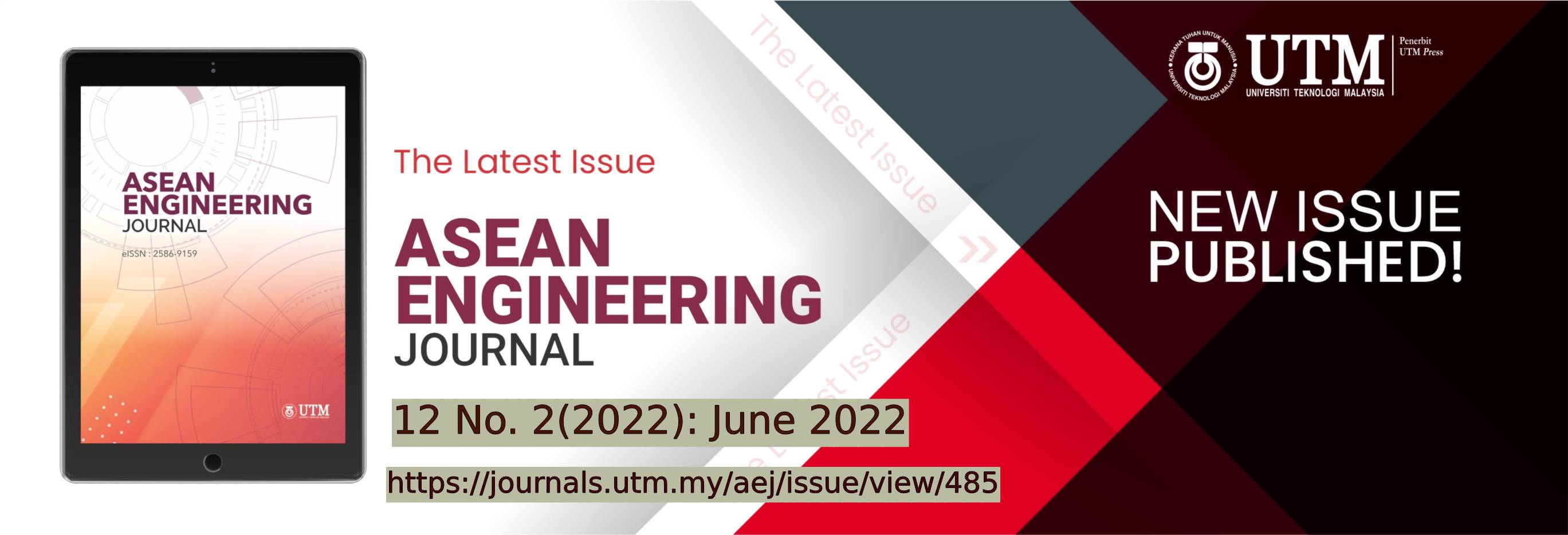THE ELECTROSPRAYED INSULIN-LOADED POLYCAPROLACTONE MICROPARTICLES AS A DRUG CARRIER
DOI:
https://doi.org/10.11113/aej.v12.16910Keywords:
Drug delivery, electrospraying, insulin, microparticles, polycaprolactone.Abstract
Drug and protein encapsulated polymeric microparticles have been considered as the most effective delivery in pharmaceutical biotechnology. In this work, we report the fabrication of polycaprolactone microparticles (PCL MPs) containing insulin via an electrospraying method. The morphology, chemical composition, physicochemical properties, insulin encapsulation and release efficiency, degradation of PCL MPs, and cytotoxicity are systematically characterized and analyzed. The results indicate that insulin do not incorporate with PCL matrix leading to the deformation of PCL MPs’ structure. In addition, insulin can be loaded into the PCL MPs with high concentration up to 25 % while it remains chemical properties when releasing from the PCL MPs. Moreover, insulin demonstrates high burst release within the first day, subsequently the release become more stable during 2-7 days. The 80% viability of the cell suggests that PCL MPs are biocompartible to cells. As a consequence, the above mentioned material is proved to be has high potential for insulin carrier in controlled release application
References
Bai, J. P. F., & Chang, L. L. 1995. Transepithelial Transport of Insulin: I. Insulin Degradation by Insulin-Degrading Enzyme in Small Intestinal Epithelium. Pharmaceutical Research. 12(8): 1171-1175. DOI: https://doi.org/10.1023/A:1016263926946
Ozku Bock, N., Dargaville, T. R., & Woodruff, M. A. 2012. Electrospraying of polymers with therapeutic molecules: state of the art. Progress in Polymer Science. 37(11): 1510-1551. DOI: https://doi.org/10.1016/j.progpolymsci.2012.03.002
Boda, S. K., Li, X., & Xie, J. 2018. Electrospraying an enabling technology for pharmaceutical and biomedical applications: A review. Journal of Aerosol Science. 125: 164-181. DOI: https://doi.org/10.1016/j.jaerosci.2018.04.002
Bruschi, M.L., 2015. Classification of therapeutic systems for drug delivery. Strategies to Modify the Drug Release from Pharmaceutical Systems. Bruschi, ML, Ed,: 29-36.DOI : https://doi.org/10.1016/B978-0-08-100092-2.00003-5
Chen, D. R., Bei, J. Z., & Wang, S. G. 2000. Polycaprolactone microparticles and their biodegradation. Polymer Degradation and Stability. 67(3): 455-459. DOI : https://doi.org/10.1016/S0141-3910(99)00145-7
Dinarvand, R., Sepehri, N., Manoochehri, S., Rouhani, H., & Atyabi, F. 2011. Polylactide-co-glycolide nanoparticles for controlled delivery of anticancer agents. Int J Nanomedicine. 6: 877-895. DOI : https://doi.org/10.2147/IJN.S18905
Ding, L., Lee, T., & Wang, C. H. 2005. Fabrication of monodispersed Taxol-loaded particles using electrohydrodynamic atomization. J Control Release. 102(2): 395-413. DOI: https://doi.org/10.1016/j.jconrel.2004.10.011
Emami, J., Hamishehkar, H., Najafabadi, A. R., Gilani, K., Minaiyan, M., Mahdavi, H., & Nokhodchi, A. 2009. A Novel Approach to Prepare Insulin-Loaded Poly (Lactic-Co-Glycolic Acid) Microcapsules and the Protein Stability Study. Journal of Pharmaceutical Sciences. 98(5): 1712-1731. DOI: https://doi.org/10.1002/jps.21544
Enayati, M., Ahmad, Z., Stride, E., & Edirisinghe, M. 2010. One-step electrohydrodynamic production of drug-loaded micro-and nanoparticles. Journal of The Royal Society Interface. 7(45): 667-675. DOI : https://doi.org/10.1098/rsif.2009.0348
Enayati, M., Ahmad, Z., Stride, E., & Edirisinghe, M. 2010. Size mapping of electric field-assisted production of polycaprolactone particles. Journal of the Royal Society. 7: 393-402. DOI: https://doi.org/10.1098/rsif.2010.0099.focus
Freiberg, S., & Zhu, X. X. 2004. Polymer microspheres for controlled drug release. International journal of pharmaceutics. 282(1–2): 1-18. DOI : http://dx.doi.org/10.1016/j.ijpharm.2004.04.013
Kim, S.-Y., Lee, H., Cho, S., Park, J.-W., Park, J., & Hwang, J. 2011. Size control of chitosan capsules containing insulin for oral drug delivery via a combined process of ionic gelation with electrohydrodynamic atomization. Industrial & Engineering Chemistry Research. 50(24): 13762-13770. DOI : https://doi.org/10.1021/ie200915x
Linh, N.-V. V., Viet, N. Q., & Dai Phu, H. 2019. Effects of the electrosprayed polycaprolactone microparticles morphology on the polycaprolactone degradation. Science and Technology Development Journal-Natural Sciences. 3(2): 65-73. DOI: https://doi.org/10.32508/stdjns.v3i2.801
Linh, N. V. V., Thinh, N. T., Kien, P. T., Quyen, T. N., & Phu, H. D. 2018. Injectable Nanocomposite Hydrogels and Electrosprayed Nano(Micro)Particles for Biomedical Applications. Novel Biomaterials for Regenerative Medicine. 1077: 225-249. DOI: https://doi.org/10.1007/978-981-13-0947-2_13
Mo, R., Jiang, T., Di, J., Tai, W., & Gu, Z. 2014. Emerging micro-and nanotechnology based synthetic approaches for insulin delivery. Chemical Society Reviews. 43(10): 3595-3629. DOI: https://doi.org/10.1039/c3cs60436e
Nguyen-Vu, V. L., Tran, N. H., & Huynh, D. P. 2017. Electrospray method: processing parameters influence on morphology and size of PCL particles. Journal of Science and Technology. 55(1B): 215-221. DOI: https://doi.org/10.15625/2525-2518/55/1B/12110
Sánchez González, S., Diban-Ibrahim Gómez, N., & Urtiaga Mendia, A. M. 2018. Hydrolytic degradation and mechanical stability of poly (Ɛ-caprolactone)/reduced graphene oxide membranes as scaffolds for in vitro neural tissue regeneration. DOI: https://doi.org/10.3390/membranes8010012
Tanhaei, A., Mohammadi, M., Hamishehkar, H., & Hamblin, M. R. 2020. Electrospraying as a novel method of particle engineering for drug delivery vehicles. Journal of Controlled Release. DOI: https://doi.org/10.1016/j.jconrel.2020.10.059
Xie, J., Marijnissen, J. C., & Wang, C. H. 2006. Microparticles developed by electrohydrodynamic atomization for the local delivery of anticancer drug to treat C6 glioma in vitro. Biomaterials. 27(17): 3321-3332. DOI: https://doi.org/10.1016/j.biomaterials.2006.01.034
Xie, J., & Wang, C.-H. 2007. Encapsulation of proteins in biodegradable polymeric microparticles using electrospray in the Taylor cone-jet mode. Biotechnology and Bioengineering. 97(5): 1278-1290. DOI: https://doi.org/10.1002/bit.21334
Zamani, M., Prabhakaran, M. P., & Ramakrishna, S. 2013. Advances in drug delivery via electrospun and electrosprayed nanomaterials. International journal of nanomedicine 8. 8: 2997-3017.
DOI : https://doi.org/10.2147/IJN.S43575
Zhang, S., Campagne, C., & Salaün, F. 2019. Influence of solvent selection in the electrospraying process of polycaprolactone. Applied Sciences. 9(3): 402.DOI: https://doi.org/10.3390/app9030402
















